The Desert War: Bolt Action Boot Camp Preparation // Part One – Overview & Origins
August 20, 2018 by oriskany
In the study of military history, certain battlefields can acquire a mythic, almost romantic allure. Even amidst the horrors of World War II, there’s one campaign that somehow seems “clean,” isolated, and almost chivalrous. This, of course, is the Desert War, fought in Africa and the Middle East from June 1940 to May 1943.
Read The Original Article Series Here
In preparation for the upcoming Bolt Action “Western Desert” Boot Camp, we’ll be taking a “wargaming look” at the Desert War and what sets it apart from the usual World War II games many of us enjoy. How can games be adapted to play in this theatre? What kind of terrain do we find, what tactics were used, and what did the armies look like?
Why Play In The Desert?
“I hate sand. It’s coarse, and rough, and irritating. And it gets everywhere …”
Even as we all cringe through one the worst-delivered lines in the history of modern cinema, Anakin Skywalker actually brings up a good point. Doing anything in the desert presents a whole stack of challenges, and wargaming is no exception. So why bother?
For starters, there’s actually a core of truth to the romance connected to this theatre. There were no SS units deployed here, and very few civilians to get caught in the crossfire. Diaries and records show there was a certain degree of “fair play” between the armies, perhaps because both sides faced the third enemy...the desert itself.
The Desert War also provides new challenges for players perhaps growing weary of French bocage or Russian steppe. The terrain is obviously very different and offers a whole new outlook and backdrop for tactical wargaming. The old tricks won’t work here, while new tactics become available.
These include “hull down shielding” for tanks and some of the first “special forces” operations. The SAS was born in these deserts, after all.
The Desert War was also incredibly diverse. About 75% of the Axis troops are Italians, not Germans. The “British” forces are often nothing of the sort, usually Indians (including troops from modern-day Pakistan, Bangladesh, and Nepal), South Africans, Free Poles, Greeks, Czechs, New Zealanders, and Australians. There were even detachments of Zionist Palestinians and an antiaircraft unit from Hong Kong.
Of course, the Americans joined the conflict in November 1942 with the Operation “Torch” landings in Morocco and Algeria. Free French and Vichy French figured prominently, sometimes even fighting each other (e.g., Syria in 1942). African colonial units were drawn from armies as far-flung as Madagascar.
For anyone who’s interested in expanding the diversity of their armies, this is a good place to start.
Furthermore, at least from 1940 to the beginning of 1942, most of the battles in the Desert War were actually quite small, at least when compared to other fronts. This smaller context can give your games a bigger comparative impact on the overall picture.
Many are the historical moments when you could accurately field the entire armoured strength of Rommel’s Afrika Korps on one gaming table, at least in larger systems.
And lastly, players who brave the desert are challenged to win with a lot less than on other fronts. These were armies often held together with baling wire and duct tape, especially in its early phases. Equipment includes the Italian M11/39 tank, armed with a 37mm gun (in the hull, no less), and the Italian CV-35/L3 tankette, an “armoured vehicle” whose deadliest feature may be how god-awful cute it is.
Not that the British can laugh, their most common tank in the early Desert War is the Vickers Mark VIb, armed with just a .50 calibre machine gun. Whole battalions are armed with the World War I-era Rolls Royce armoured car (at least they got rid of the bicycle spokes in the wheels). In short, when it comes to armour the early Desert War can be summed up in three words … “pew-pew-pew!”
Even later, this was hardly a “Clash of the Titans.” Forget Panthers or Fireflies. A Matilda II with a 2-pounder or a Panzer III with a 50mm gun is mighty, and when the basic Sherman first appeared in late August of 1942, it was practically (and briefly) god-like.
Yet when it comes to Bolt Action, I feel this makes the Desert War actually very good fit. Poor armour (at least when compared to other theatres of the war in simultaneous timeframes) gives infantry has a better chance to take a greater role on your 28mm battlefields.
I feel 28mm wargames (Bolt Action definitely included) are at their best for historical and military realism in the context of an infantry firefight.
Origins Of The Desert War
Why Fight Over Piles Of Sand?
The Desert War started almost by accident in the summer of 1940, primarily by the Italians. Yet the Italians initially had no intention of getting mixed up in World War II. But when Germany was overrunning Western Europe, Mussolini abruptly felt like he was missing a moment of destiny. With France crumbling and Great Britain about to fall out of the war, perhaps Italy could snatch overseas territory from the far-flung French and British empires.
Again, Mussolini’s military commanders warned him that Italy’s armed forces were years…perhaps a full decade…from being even remotely ready. Mussolini assured them there would be no real fighting, with the armies of Britain and France collapsing, these colonies would be basically undefended. “All I need is [to suffer] a few thousand dead” he cynically remarked, “and I can sit at the peace table as a man who has fought.”
Sadly for hundreds of thousands of Italians, Mussolini would accomplish the first part of his goal in remarkable scale. First, his June 1940 “grand invasion” of southern France was bloodily repulsed by just six French divisions, even as the rest of the French Army was collapsing against German “Case Yellow” and “Case Red” invasions up north.
Even with these setbacks in France, Mussolini launched near-simultaneous invasions of British colonies in Africa. Here is where the Desert War officially gets started, but not in the “classic theatre” of Egypt and Libya, but in British-held Sudan, Abyssinia (modern Ethiopia), and British and Italian Somalia.
Believe it or not, Italians actually enjoyed some initial success. First, their army in Ethiopia invaded the British colony in Somalia in August 1940 (when the Battle of Britain was just reaching its greatest pitch). The sheer weight of numbers delivered an Italian victory, and the British were forced to evacuate “Dunkirk style” to Aden. This was the only Italian offensive operation to deliver success without significant German help.
Hopelessly outnumbered, the British fell back to the Assai Hills, where the high ground gave British would hopefully give British an advantage. Several particularly nasty engagements took place at a place called Tug Argan, a fortified British position blocking the road to Berbera, the main port from which the British were planning their retreat.
These battles have served as the backdrop for our some of our past desert wargames, some photos of which are featured in this article. In our games, the “British” force was made up primarily of the King’s African Rifles (“Nyasaland” Battalions from modern-day Malawi), backed up by a Pakistani battalion of the 15th Punjab Rifles, supported by East African Light Artillery (18/25 pounders).
The attacking Italians, meanwhile, lead off with the 7th Colonial Brigade (very solid East African “askari” troops), a handful of wretched M11/39 tanks and L3/CV35 “tankettes”, and a battery of “75/18 modello 34” light howitzers.
In any game portraying this very first battle of the Desert War, the Italians should have a significant edge in both numbers and direct artillery. Clearly the British have to make the most of their high ground, off-board artillery, and long-range rifle fire in order to pull off a win. The Italians, meanwhile, have to push up the British-held high ground and establish footholds in towns, settlements, and fortifications like Tug Argan.
Libya & Egypt
Next, we come to Libya and Egypt, the “main theatre” people remember from the Desert War.
Mussolini’s next invasion was launched by the Italian Tenth Army, striking out of the Italian colony of Libya, against the British “Western Desert Force” stationed in Egypt. If the Italians could follow up their success in Somalia with wins in Egypt and later Sudan, then all of northern and eastern Africa, from the border of Tunisia all the way to Tanzania, would be one sprawling Italian colony.
Again, the invasion seemed like it would be a walkover. The Italian Tenth Army outnumbered the WDF by almost 10-1. Besides, the British were “about to lose” the Battle of Britain and face the “Sea Lion” invasion at home, surely they would cut a deal as soon as 200,000 Italian troops marched into Egypt.
Wrong. Although they were admittedly too small to actually halt the Italian Tenth Army, the tiny WDF put up a skilful fighting retreat. One interesting little battle came at Alam an Dab, where a force of British infantry was about to be cut off and the 11th Hussars got the order to mount a motorized rescue.
Again, the battles start off very small, with “armoured vehicles” that are almost laughable. These were engagements determined by infantry, towed artillery, and above all, supply. In many photos, the terrain looks flat and featureless, but don’t be fooled. Even the most subtle dune can provide complete concealment or at least a hull-down advantage.
Alam el Dab was one of the few “mobile” battles of the Italian invasion since most of their Tenth Army was “leg” infantry. Yet even most of their “tanks” were armed only with machine guns. For an actual cannon, the Italians had only a handful of M11/39 tanks, armed with a 37mm gun (in the hull, no less).
British antitank capability at Alam el Dab was even shakier, with just “Boys Antitank Rifles” mounted in some universal carriers and 1920s-era Rolls Royce armoured cars. This was a .55 calibre infantry rifle (think of the large sniper rifles carried today) that could shoot through very thin armour plate. Fortunately for the 11th Hussars, “very thin” was all the Italians had.
When the Tenth Army reached Sidi Barrani, barely sixty miles inside Egypt, they simply…stopped. With only a handful of vehicles, 200,000 men couldn’t walk all the way to Cairo. So they dug in and basically waited for the war to end. But of course, the war didn’t end in September 1940. Britain didn’t fall, and the British WDF was already preparing one of the most epic counterattacks in World War II.
Of course, our Desert War series has barely started. Upcoming articles will cover the “British Blitzkrieg” that was Operation Compass, crushing the Italians so badly that the Germans finally had to send help. That help would come in the form of Erwin Rommel, commanding a handful of threadbare, incomplete panzer units that history would soon immortalize simply as the “Afrika Korps.”
Leave your comments, questions, and feedback below. Thinking of jumping in the Desert War? Will you be attending the upcoming Boot Camp? Watching the live blog?
What parts of the Desert War interest you the most?
"I feel 28mm wargames (Bolt Action definitely included) are at their best for historical and military realism in the context of an infantry firefight..."

"Leave your comments, questions, and feedback below..."
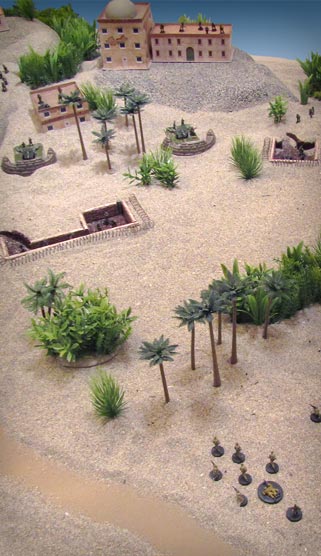








































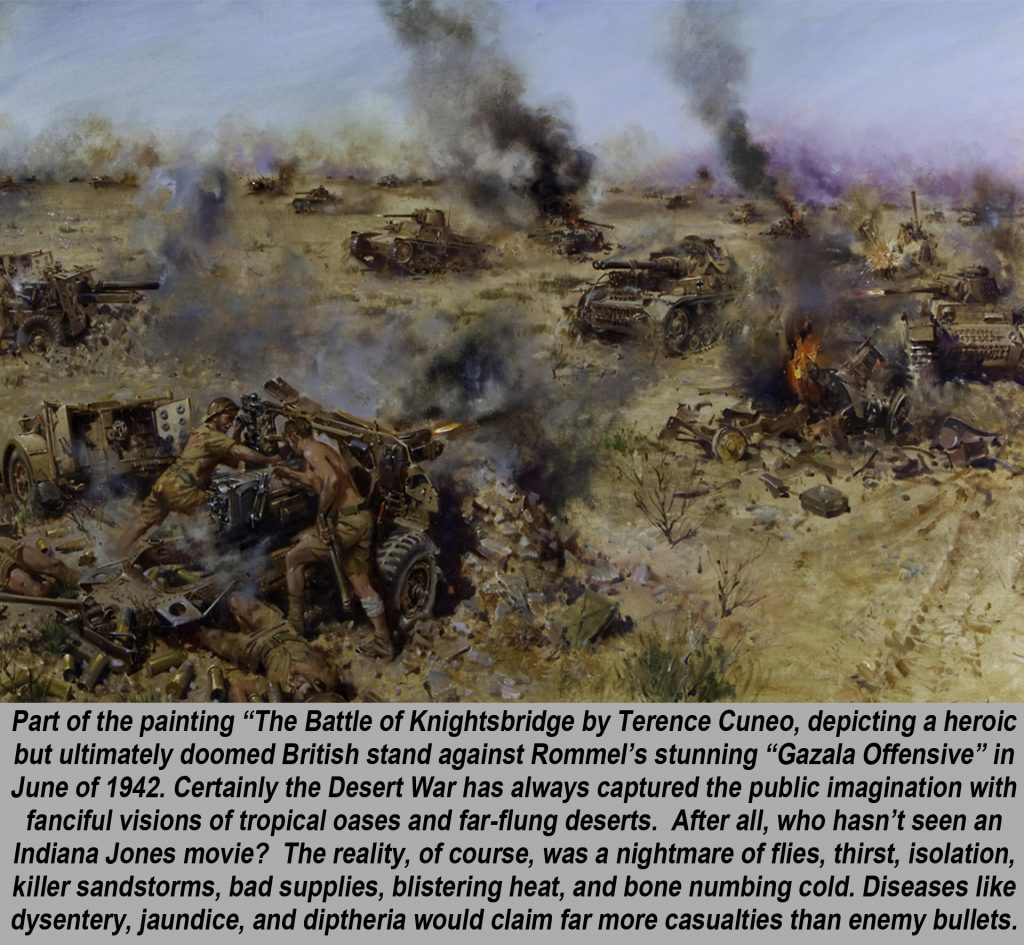
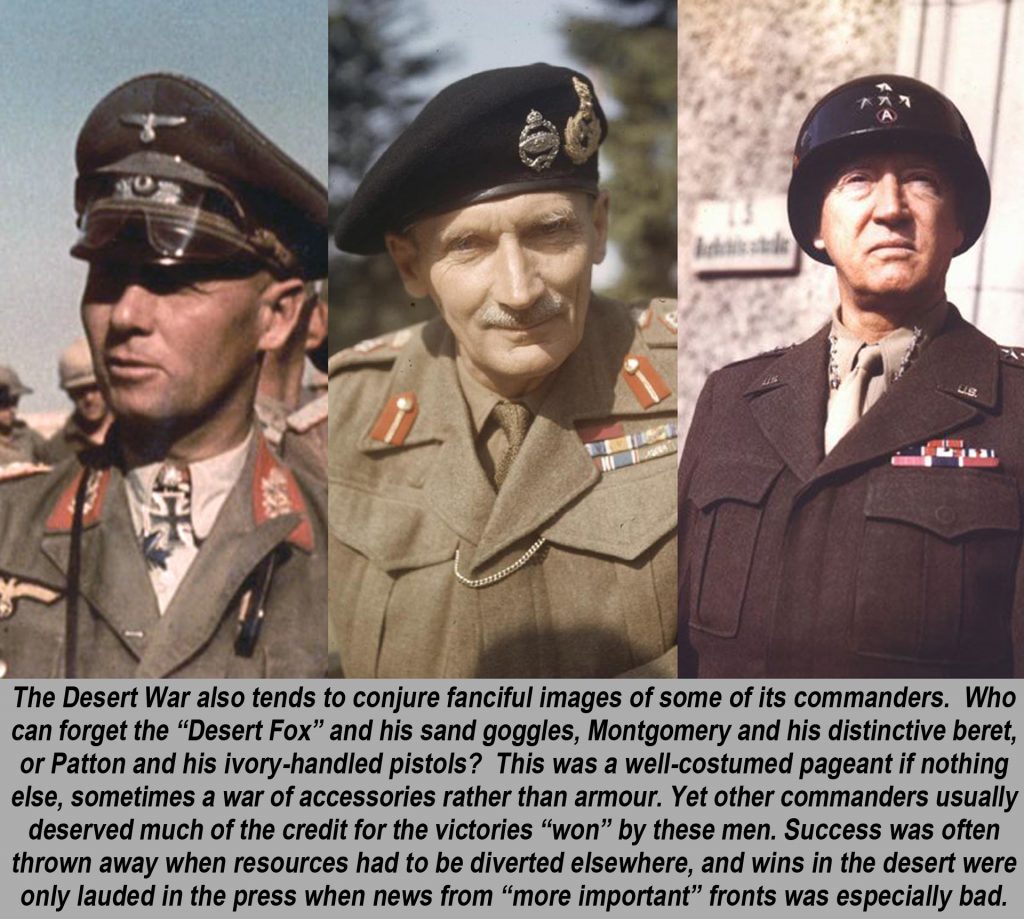

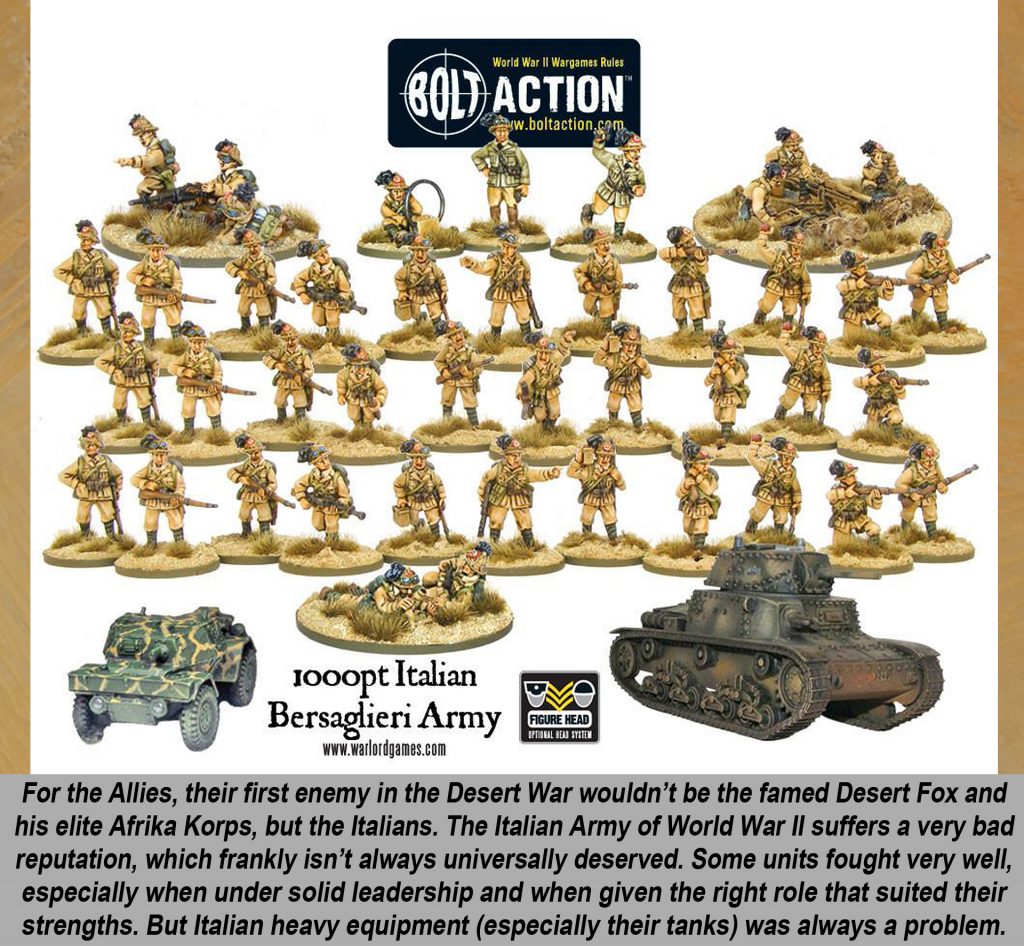
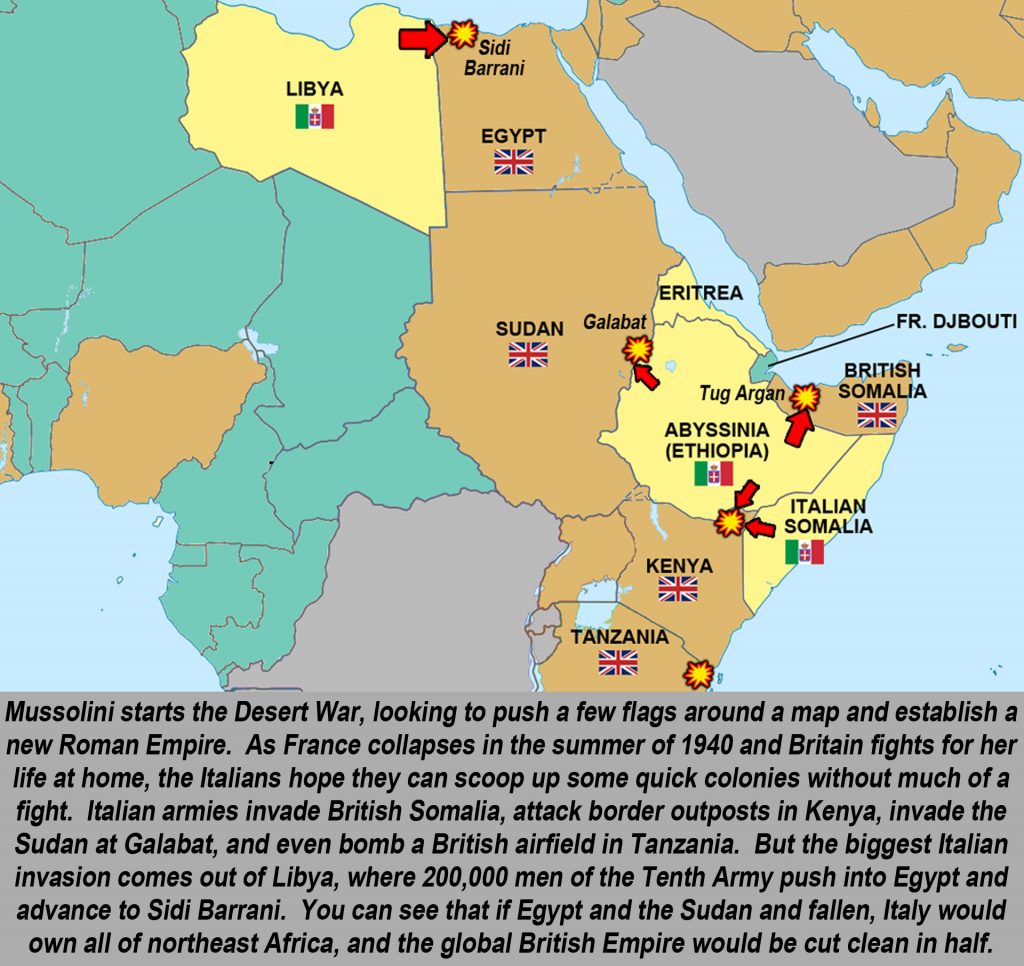
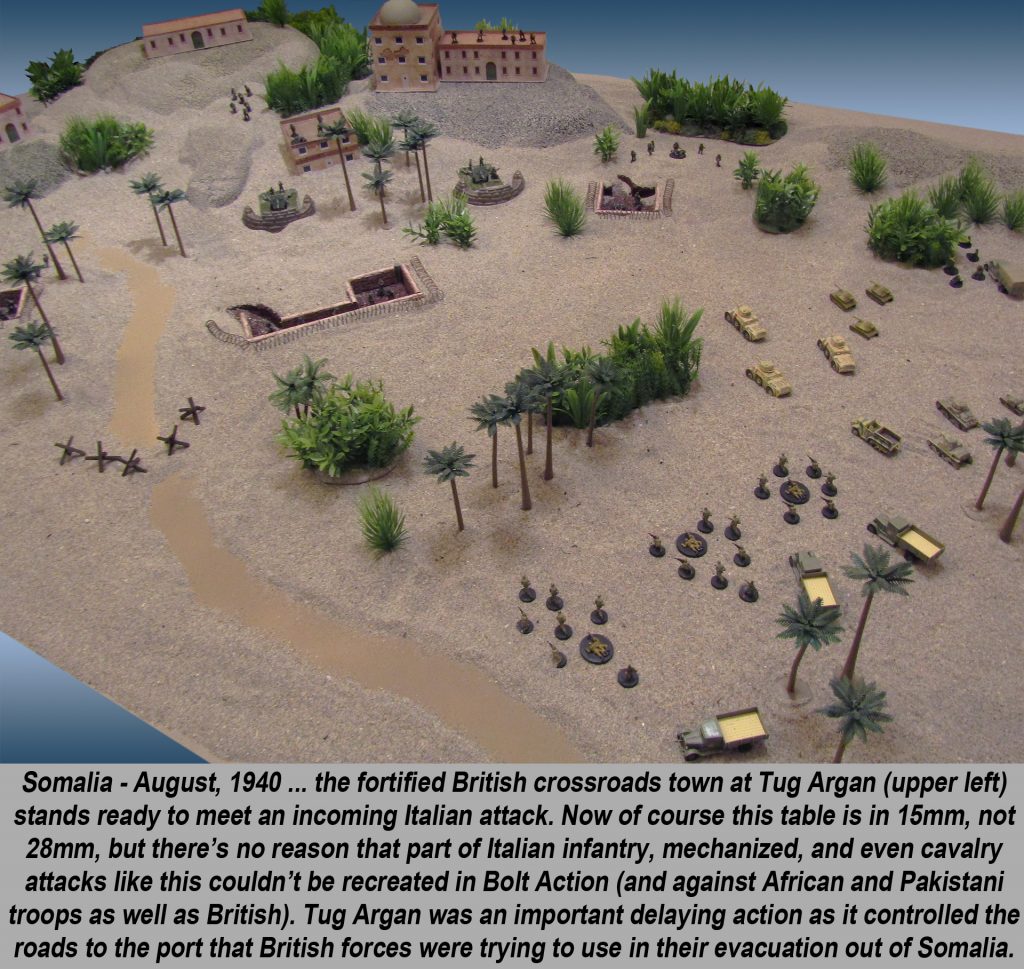
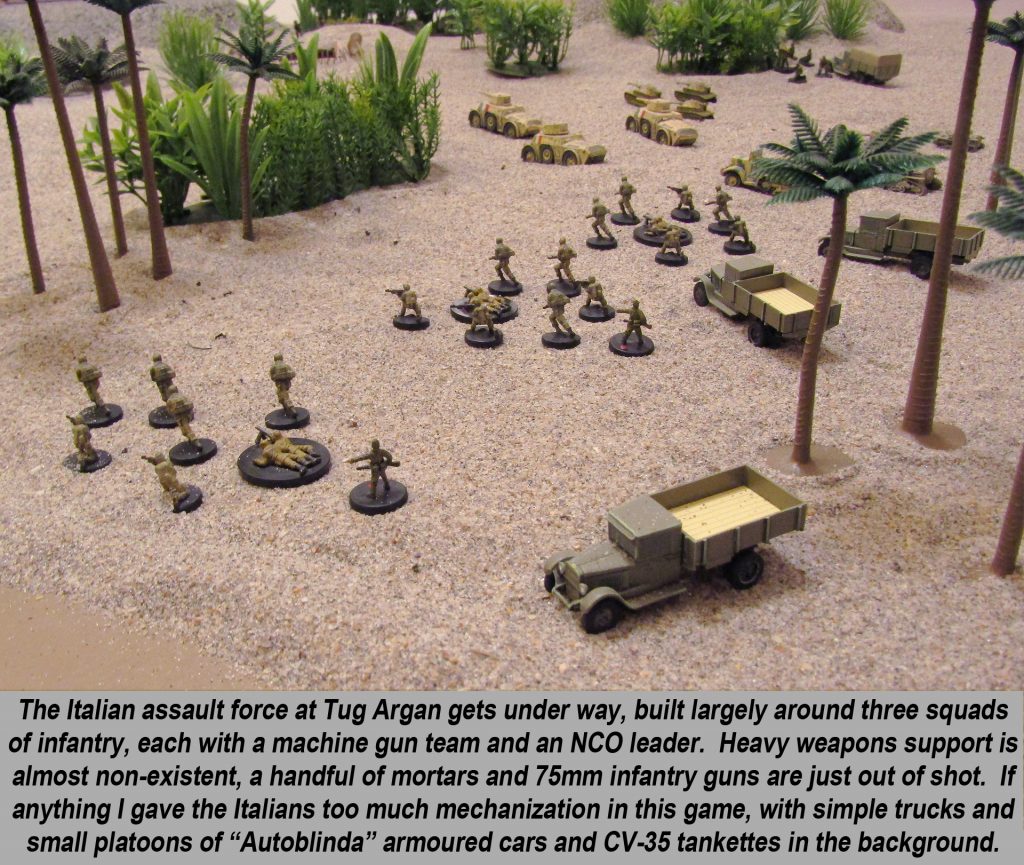
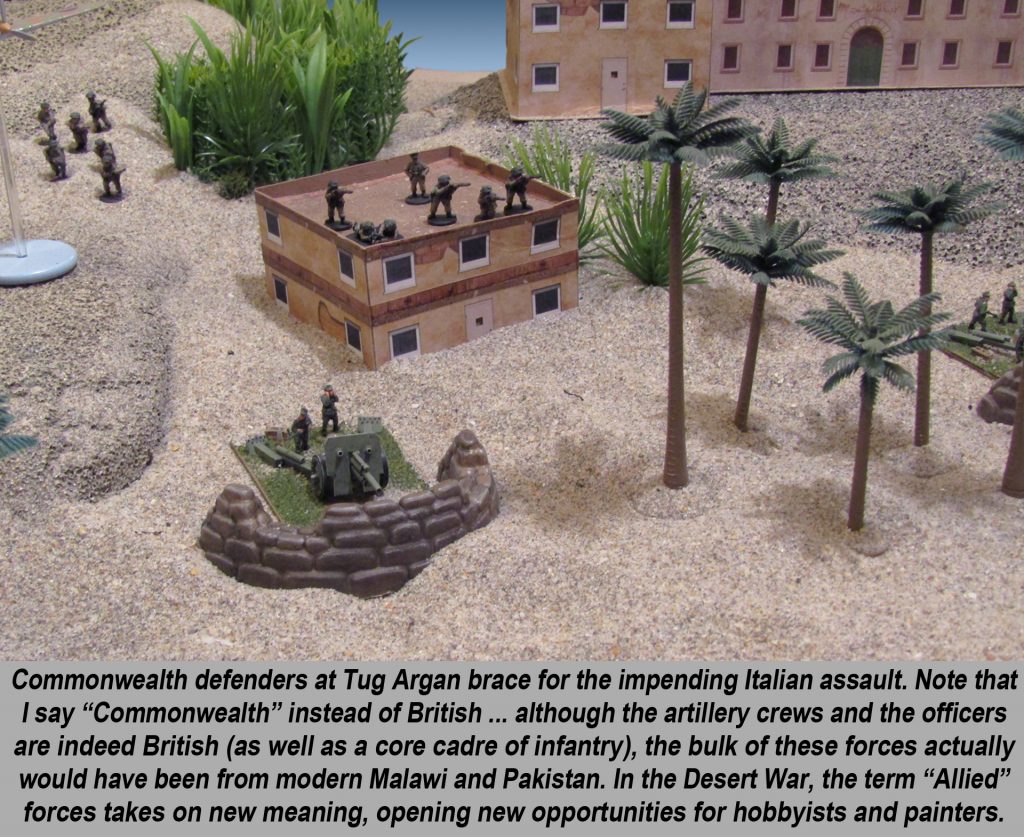

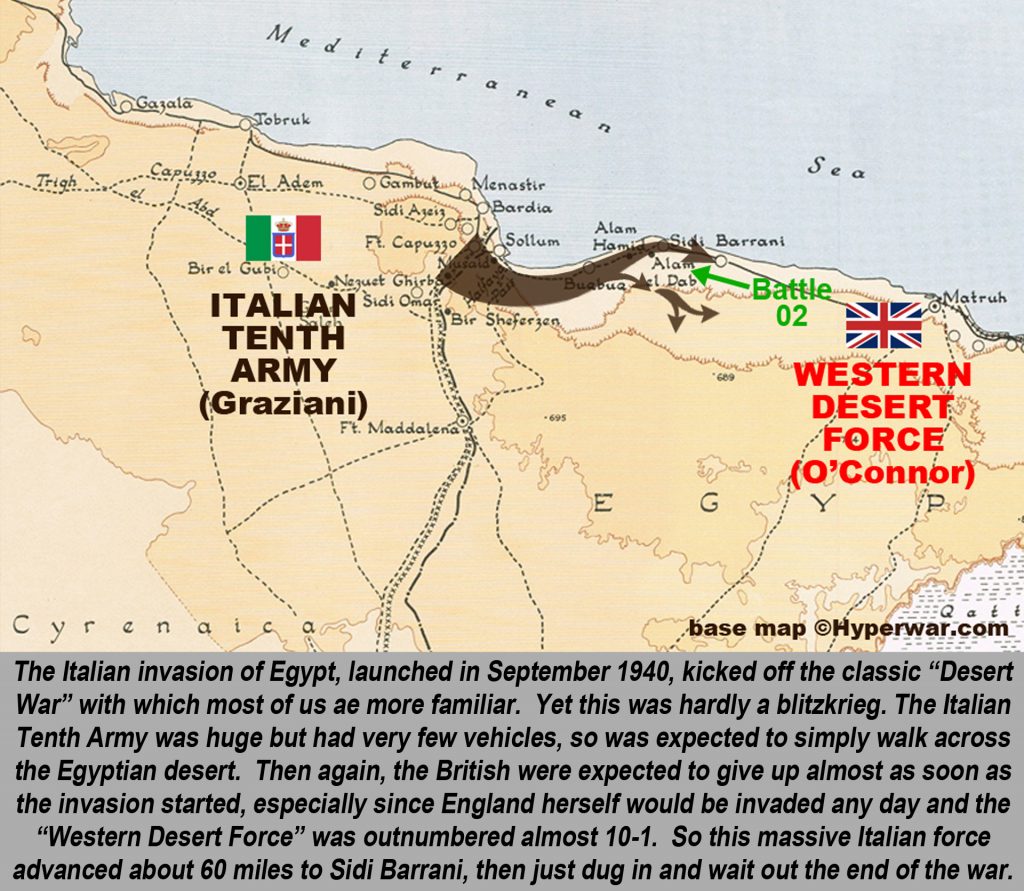
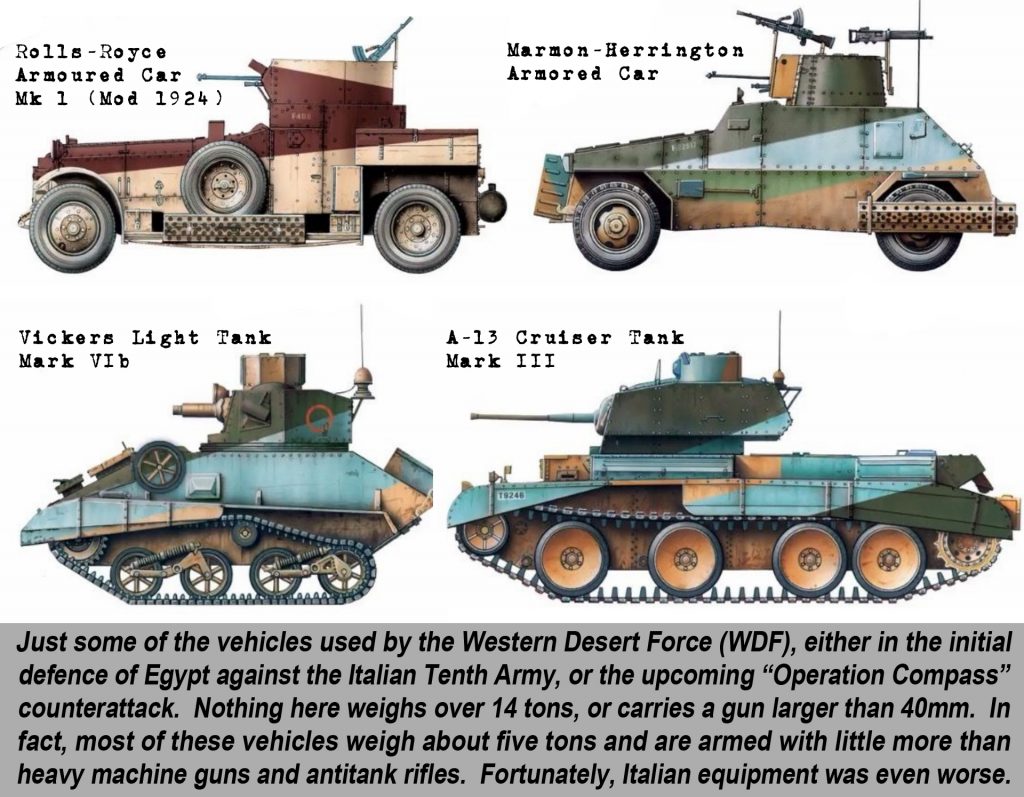
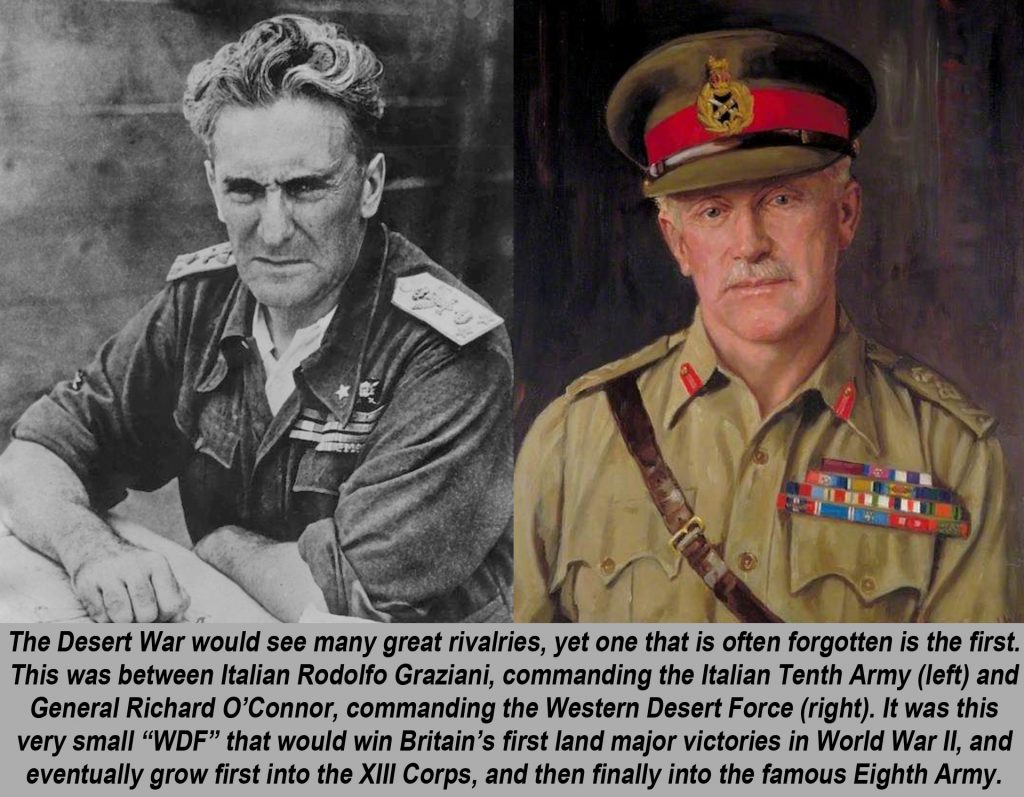






























Very cool and great to see some Desert Stuff before the Bootcamp.
I’ve played a few games of the new V4 Flames of War in the Desert and it’s awesome. The Desert really is perfect for smaller games just like the early war in Europe except you have access to a wider range of troops.
Thanks very much, for kicking us off, @elessar2590 ! Wow, all these comments before I even log in this morning. Great! I’d better catch up quickly.
FoW 4.0 was indeed awesome at the last Desert War boot camp. Better for big tank battles, I’m interested to see the smaller-scale infantry engagements with Bolt Action at 28mm.
And you’re absolutely right about the diversity of troops – all told there are easily something like 20 nations involved in the North Africa / Middle East theater. Depending on how you count, many more.
Great article, thanks Jim. Really looking forward to this bootcamp
Thanks, @buggeroff ! Yes, a re-run technically, but given a refreshing make-over to bring greater focus on Bolt Action and the upcoming boot camp (and replace some of the older photos). 😀
Looking forward to seeing you at the boot camp! 😀 😀 😀
excellent article as always Jim. I enjoy getting the background and historical perspective before @warzan gets a chance to rewrite it 🙂 you know I love you Warren.
@warzan changing history never happens you know he’s a history grognard now!
That’s very true! 😀
Thanks very much @avernos (Gerry). I would remind you, though, that @warzan is now a card-carrying member of the International Historical Wargamer Grognard Society. 😀
Always good to read some @oriskany history stuff and getting gaming suggestions for all kind of rule sets. In the desert theatre I´m particularly interested in the battle of Tobruk, the second battle of El Alamein and finally the Americans. The latter is covered in a fabulous article series by oriskany. Read it and like it. As for the different type of troops the British fielded I studied the sprues for the new up-coming 8th Army boxed infantry set from Warlord. They have a great variety of heads in it including some with turbans and many other versions. No great… Read more »
Thanks, @jemmy – Indeed Tobruk is interesting, especially when you consider how long that “battle” went on for. Rommel’s initial attempt to overrun and take the port off the march, the bloody nose he got there (losing one of his top commanders in the process), the “siege,” I put that in quotes because the town was really never cut off – the 9th Australian or course, the inclusion of Polish and Carpathian units that are added in later, British attempts to break in in Operation Brevity, Battleaxe, and finally Crusader (look for this in Parts 02 and 03). El Alamein… Read more »
The Italians v the Carpathians I never knew the desert war lasted that long @oriskany Lol
Hundreds of years, @zorg ! it’s nutz! 😀 😀 😀
It’s the dry sand you take for ever to get anywhere. ?
Yeah, I hate sand. It’s coarse, irritating, and it gets everywhere …
Oh wait, I did that joke already 🙁
Ha.
😀
ooo thanks, I will do some brushing up so I feel less newbie at the boot camp.
No worries at all, @laughingboy – that’s part of the purpose of these articles, and re-running this series in particular, to sketch in some background for the Desert War for those who are interested before the boot camp event.
Nice intro Jim. Nice scene setter for the Bootcamp, be interesting to see what we get in the army packages and how we can fit them round your articles. Wonder if they allow the British players to do Jock Columns?
Plus I have models in 28mm of all the British stuff above and quite a lot if Italian (not a M11/39 though).
Thanks, @bobcockayne – great questions – my only possible comment re: Jock Columns is that Jock columns require a lot of vehicles, Rolls Royce and early-model Humbers, trucks, universal carriers for light artillery / 2 pounders, etc. I honestly don’t know how many vehicles are coming with the army packs. I would also add that Jock Columns have a pretty specific and narrow window in the historical time frame – perfect for this particular article (early war) not so much for the overall sweep of all the Desert War. The Jock Column tactic was discontinued pretty early in the campaign… Read more »
@oriskany was actually thinking about a Sat night end game with everyones forces combined more than individual. As for your observation you are on the ball as usual,Jjock columns only really worked against the Italians , and the more mobile Afrika Korps made them fairly ineffective from bits I picked up from various sources. Me thinks will have to research further,
Quick dig to remind my self about Jock columns, and apparently they were dis continued as it tended to split up the armoured units into penny packets which a certain ‘Desert Fox was very good at exploiting.
Fun to wargame in Operation Compass, as we’ll see in Part 02. 😀
@bobcockayne – Megagames are indeed awesome! Combining everyone’s (or at least several players) together on a multi-table smackdown! The one we had for the FoW 4.0 was great, we had 12 players going at once, all of which were attacking ME of course!
(just kidding) …
(but not really) …
https://www.youtube.com/watch?v=9qFyP-MlfPk&t=47s
@orisakany I phibbed about the M11 do have one, going through the painted Desert stuff last night, and found one I’d forgotten about, I’d put a camo scheme on it and A British Facxist insignia as it was pressed into use as part of my Very British Civil War Italian Contigent, theres a light tank as well, Also for Desert had a M13/40 an Autoblinda , a CV33 . Germans a lone Panzer 2, Bitishs LDRG 2x Fords one with 37mm Bofors, 3 chevies and 3 Jeeps plus about 24 ft figs 10 Sikhs 10 Gurkas 1 x A13 1x… Read more »
Holy hell, @bobcockayne – that’s a massive force! especially in 28mm. 😀 I love the inclusion of all your armoured cars, too. NOW we’re starting to look like a Jock Column, except for maybe that Matilda as it may be too slow (I’m assuming that’s a Matilda II with the 40mm / 2pounder)?
Yup and forgot 1 x section Afrika Korps and 1x section Italians desert and 1x in European Dress(think could be used, vaguely remember Osprey showing Blacks shirts in european uniform)
Think only the Morris is a metal model, think the other two are resin so they may fit with out over doing weight allowance.
Are you bringing these to show off? Or are you getting ready for “free gaming” on Sunday afternoon? 😀
Initially was going to bring one Afrika Korps figure so could get near new ones near to the ones I did many years ago. The others were just suggestions I think Rob was on about bringing his LRDG , hence foot figures mentioned. I’d like to show them off, but not sure how well they’ll take the pounding even with them in box on lap on plane. Much as I’d like to bring them all to show, I’d the infamous Kevin to take a car over! Trouble is also got to get new stuff back and we have neigh idea… Read more »
Awesome~ You’re talking about the Giovanni Fascisti (136th Infantry) units? I honestly don’t remember if they wore black shirts in the desert. I don’t think so. There’s also “Regio Esercito” – agauin, I think they eschewed the black shirt in the desert – I see some images of them with desert sand shirts / jackets OVER black shirts.
Black is just not usually a good idea in the desert heat. 😐
A very welcome refresher before the Bootcamp ?
I totally agree, infantry skirmishes with a little fire support will fit Bolt Action perfectly. I’m quite sure we will fight out some interesting little scenarios over the weekend ?
Thanks, @suetoniuspaullinus – I’ve seen some of the ideas the guys are working on with Warlord and 4Ground for terrain, indeed some great scenarios seem to be in the making! 😀
Army painted and based by Saturday morning? 😉
Hey, there he is! Thanks for the comment @rasmus! This thread is so long I didn’t see you at first! 😀 😀 😀
This theatre is one of the most interesting to me, its the back and forth nature of the theatre that lasted 3 years that makes it interesting. It should not have lasted that long after giving the Italians a damn good thrashing, Churchill turned his to the obsession over Greece( which was a hang up from WW1)and let the Germans get foothold.
I think that it will work really well with Bolt Action cannot wait to get the Jeeps and Chevy trucks rolling at the boot camp:-)
If we had all the various LDRG groups various people have, Jim would be able to plan the games for the whole unit!
@commodorerob – agree 100% about how Churchill’s intervention vis-a-vis Greece / Crete wound up really crippling General O’Connor’s plans for a follow-up phase to Operation Compass – which almost certainly would have thrown the Italians completely out of Libya and ended the Desert War practically before it started. Or would it have? Say the British really do take ALL of Libya with “Operation Compass II”? Then what? The Vichy colonies in French northwest Africa, starting in Tunisia, are still viable threats, and in turn under threat from these expanding British successes. Does Rommel get sent to TUNISIA instead of Tripoli,… Read more »
@oriskany good analysis that is pretty much what David Row proposed in his Alt History in ‘The Whale has Wings’ series.
@bobcockayne – Of course the parallels between a Tunisia-based alternate history and the Libya-based actual history would’t be perfect. One major difference would be supply. As we’d see in 1943, the Axis had a much easier time keeping a bridgehead in North Africa supplied in Tunisia because of the shorter shipping lines, Sicily being just 100 miles northeast, etc. By the same token, the Allies might have had an easier time supply. The distance between the Mareth Line and TRIPOLI is much shorter than say the Capuzzo/Bardia line and Alexandria. Assuming the British could have taken Tripoli in good shape… Read more »
My vote would be the LRDG / SAS raid at the airfield at Derna in Cyrenaica, Sept 1942 I think. It would be tough to create in miniature (we’d need a lot of 28mm planes for the runway) but would be epic Hollywood desert=adventure-movie awesomeness!
Meanwhile, received my LRDG / SAS 28mm Warlord stuff and starting on a small force (say, half of a historical LRDG patrol).
Two Fat Lardies did a game base on that a few years back at Salute, think it was when they were introducing ‘Troop and Tactics’ which was pre Chain of command.Lots of Junkers JU52’s and Ju 87’s , poor old john would be building them for weeks, hope @warzans not reading this.
We actually DO HAVE THIS exact battle done in Part 04 of this series – although only in part and in 15mm. I agree doing it in 28mm would take up the whole studio and be a metric ****-ton of work, but it would look awesome!
The biggest issue is we’d need a whole new faction. From what I understand we’re getting German and British troops at the boot camp. We’d need Italians.
I have 1 squad of desert Italians ,1 squad of Italians in grey (done for very British Civil war) could be Blackshirts.
@bobcockayne – A super-quick preview of our airfield from the LRDG / SAS raid on Barce:
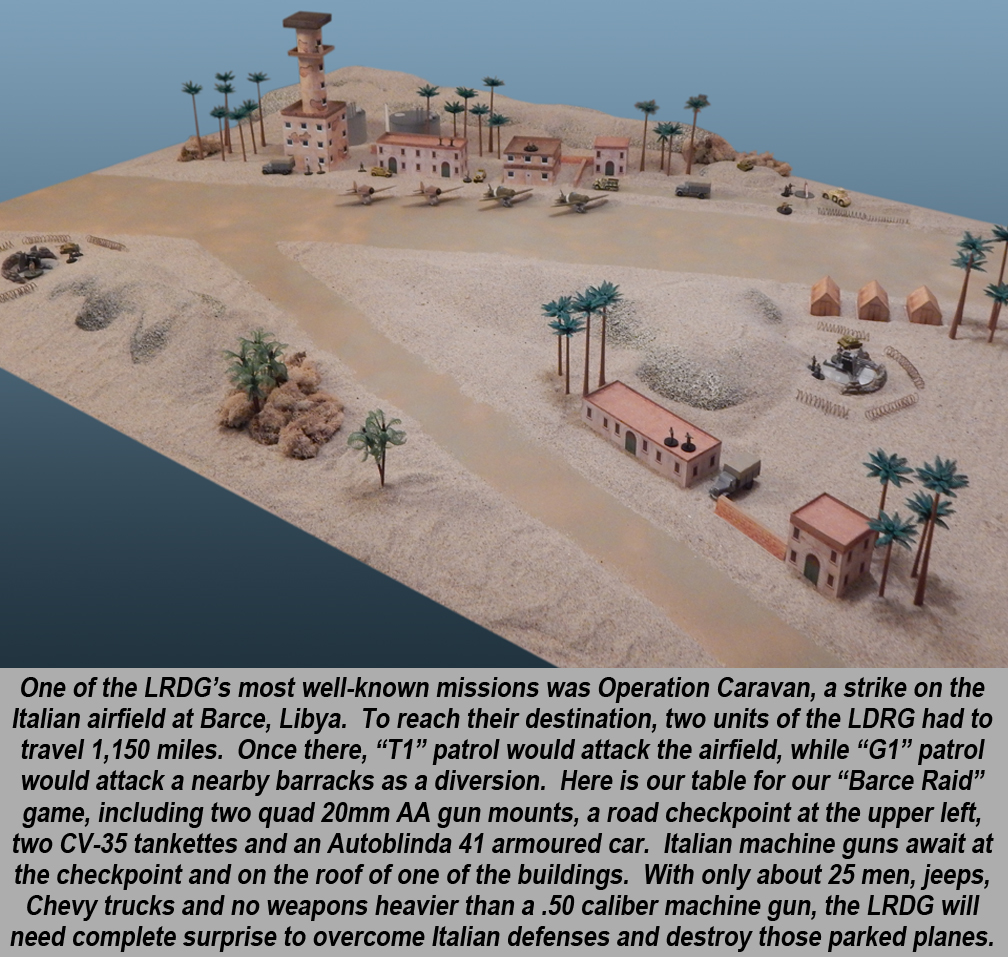
does anyone actually do Aircraft in 1/56 or 28mm scale?
!/48th are close enough
Actually @commodorerob, I have no idea. Very new to 28mm gaming myself. Even the few times I’ve tried BA (besides all the videos I’ve seen on it), we’ve done it in 15mm.
I would agree, @bobcockayne – especially since in this case they’d be more for scenery, terrain, and most importantly, objectives.
Fair enough…i may go hunting for some planes 😉
Sounds great everyone – I would just ask a quick question, @commodorerob and @bobcockayne … to level-set and make sure we’re all on the same page. Maybe I’m being paranoid here, if I am then apologies in advance. So a lot of people are coming up with a lot of really great ideas for gaming here during the boot camp. Gangs of Rome, Panzer Leader, larger games of Bolt Action / potential LRDG raids on Barca airfields … I just want to make sure we’re all on the same page regarding what we have time to actually do during free… Read more »
Nope @oriskany think were on same page, at moment only suggestions, see my other post. every time I think of bringing stuff end up with nightmare of packaging/damage. Nice reminder about time, think just getting stuff we get semi painted is going to be a marathon, and you have to think of a background setting to what were getting to be in background. Extra stuff would possibly throw a monkey wrench in works even if possible. Was planning to bring some background books on Afrika Korps and that will probably take up most of luggage space. Keep worring Jim and… Read more »
@oriskany, I think separation of things here. 1. From Friday to Sunday morning will be full on bolt action, I won’t be painting anything in site this time, and as I know the BA rules to some extent I am interested in getting people playing asap. I am just pondering a couple of potential scenarios. 2. The free gaming on Sunday, The gangs of Rome game is going to be me learning about it from Gerry and Mick and possibly Lloyd. At that time you I guess will be playing Panzer leader. Also I am arriving in Northern Ireland on… Read more »
I’m arriving early morning on Thursday and don’t fly back till Monday evening, current plan was to hang about till @damon turns up and catch a lift. I was thinking about a run through of the curator stuff if we got chance.
@bobcockayne not a problem I think that a few of the curation team will be there:-)
Okay, several responses here … @commodorerob – Gotcha. Didn’t realize you’d be “starting early.” But most people will be building and painting their armies on Friday and probably a little bit of Saturday (if past experience is an indication) – so you might not have too many opponents for early play? So the Curator Role, is that for cataloging games, etc … or old archives of past threads that were archived in BoW 1.0? Am I getting Archive and Curator mixed up? Lastly, and I don’t want to speak for the BoW team here … but I’m really not sure… Read more »
No problem at all, @bobcockayne – I’m just a natural worrier when it comes to planning. I’m in good shape, the nature of my game and armies I’m bringing are such that it’s no big deal to pack and bring them, and if things don’t work out, I’m out nothing but a little bit of prep time. I’m just looking out for the rest of the participants, for whom investment / hassle might be greater.
@oriskany the Curator role is to help look after the website, make sure that all the data entered by the community is as complete and correct as possible, I have been leading on this and working with Warren and Tom and Lloyd to build the curation team and refine the purpose and also help develop other things, which is likely what I will be doing on the Monday 🙂 Funnily you should mention Archives, whilst I am an Information Manager by profession I am also a qualified Archivist, so in theory I could deal with the old stuff as well… Read more »
Also from my experience from the Bootcamps there are always the odd speedy person who is up for getting a game on the Friday, other than that I will be making tea and coffee for people…lol
“Data entered by the community” – game ratings and such? Gaming locations? Cool deal. And re: getting done early – I will take your word for it – that person is never me. 😀
I just heard about Operation Exporter. When British Commonwealth and Free French forces fought against the Vichy in Syria and Lebanon in 1941. Might make an interesting mini-campaign.
French put up a good fight captured an entire Indian Battalion If I remember rightly.
@72draco – indeed, the British / Commonwealth / Free French invasion of Vichy French Syria JUST MISSED being included in Part 02 of this original series. But I have written about it more extensively when playing through / reviewing Brian Train’s Desert Leader series for Panzer Leader. Brian’s scenario (with some extra graphics I added) is presented below:
Indeed, @bobcockayne – Vichy units put up pretty strong resistance in many theaters. Here in Syria, Desert Leader Situation 06 (scenario card above) we see a good one (if a sad chapter in French history) where Vichy French and Free French fought each other and actually inflicted pretty grievous casualties on each other.
I guess wars between brothers really are the worst.
Also Vichy forces kicked in some American teeth as well, as we’ll see in Part 05 of this series with the Operation Torch landings.
Great start. The state of the British equipment at times was even more dire than first appearances. At the beginning of the campaign, during an attack against Fort Cappuzo, the Subaltern commanding one of the Vickers light tanks could only fire his revolver at the Italians and his gunner had to use his rifle, both firing through the holes in the front of the turret where the twin MGs had been removed while the vehicle was in transit from England!! Don’t have any of the really early stuff, most of my BA collection is tailored to the later part of… Read more »
Thanks very much, @damon – and I agree 100%. These early war desert battles are a true “clash of the lawnmowers” when it comes to tanks, AFVs, and vehicles in general. Not only are you early war, but the combatants are two countries that are not prepared for war in general (UK and Italy). Then you add on the fact that this is the lowest priority in the supply chain (for the British it was home defense and the Italians were being strong-armed into Barbarossa prep by the Germans) … and you really have some borderline-laughable equipment and equipment failures.… Read more »
What were Commonwealth and Afrika Korps squad tactics at this stage of the war? Were they based around the LMG/MMG?
Aha, great question @richsh – to address this EXACT QUESTION in greater detail we have some interviews / live streams lined up before the boot camp to start addressing these questions. IN SUMMARY, though, the British are largely based on the Bren LMG. Moving up to platoon and company level we start seeing 2″ mortars, with 76mm mortars coming in with a weapons section at Battalion level. Early in the war we’re still looking at the Lee Enfield rifle, larger numbers of SMGs don’t start entering regular service until later (reserved for commandos, LRDG, SAS, etc at first). By this… Read more »
Many thanks for that. I really don’t know much about Italian force organisation so that is really interesting. I’m really interested in how German tactics used in the Early War European theatre changed during the North Africa campaign so looking forward to Part 2.
No worries at all, @richsh – at this small of a level, really down into the squad and fireteam level, it’s almost the “quantum physics of elementary particles” when it comes to how units behave on the battlefield. 😀 Really it comes down to support weapons within the squad or platoon. These heavier weapons are what determine how a rifle fire team / squad / platoon can suppress enemy defenses and thus maneuver towards or around them. Ironically, it’s this “firepower” than determines your envelopes for maneuver. The more volume, flexibility, precision, and options you have for this firepower, the… Read more »
Great read.
Getting primed for next month with all this NA background.
Thanks very much, @leifer1971 – very glad you’re finding the article series useful! 😀
Great article as always. Can’t say I have delved too much into the early desert war. Interesting to find out a little more. I thought DAK were in it from the start trying to take Egypt and disrupt oil and transport routes, oh my ignorance. Strange to think it was caused by the ignorance of Mussolini and his trust in his allies to win a war for him. Great to see the Caunter patterns. I don’t know what the boot camp will hold but I have a feeling I won’t get to paint that scheme and deal with the controvisy… Read more »
Thanks for the comment, @soapdodger … yeah, if I had a nickel for every time I heard someone say Rommel was driving for the Persian Gulf oil fields … I’d be king of the solar system by now and BoW / OTT would have a football stadium for its studio by this point … 😐 No one’s fault, just a lot of bad TV documentaries out there.
Now when we say the Axis may have disrupted transport routes – if we include the Suez Canal in “transport routes” – then yes, 100% correct on that one.
A great start the problem with Italian tank’s is like the Japanese the were good when they were designed but technology and advances overtook them quicker than expected like many other early war tanks.
@zorg – No one talks about Italian tanks in the desert better than David Fletcher – follow this link to get straight to the 15:48 mark of this video you’ve probably seen. My favorite part: But the construction of the tank, even by British standards at that time … and that’s not saying much … is grim. It’s not even riveted, the whole thing is BOLTED together. And the risk of rivet heads breaking up are bad enough. Bolt heads are BOUND to break up. All you’d need is an impact from a high explosive shell and this thing would… Read more »
love the program bolted together Wow the whole series is great @oriskany.
Not bad for a TV documentary. Stays within a strict focus so doesn’t have to oversimplify too much.
This was a great article! (Despite quoting one of the most annoying characters in one of the worst movies) Having covered the nitty gritty of history earlier, this article was a nice way to focus even more on the gaming side of things.
Hey, come on, now @gladesrunner . We all know Hayden Christensen is an accredited and important historian.
This. Is. Fantastic @oriskany – thanks so much for putting this together. Utterly gripped already Part2part2part2!!!! (please)
Thanks, @irishsteve . Just trying to get people geared up a little for the boot camp. 😀 We have lots more to come, four more parts of this series, some Weekender segments and hopefully even a live stream, all BEFORE the actual event.
I am most interested in the evolution of the airborne forces, and the history of the 509th Parachute Infantry Battalion, COL Edson Raff, and the brief history of the Tunisian Task Force. Raff’s command is a case study in aggressiveness and calculated risk taking, that is rare in the US Army in World War II. From the first US combat Airborne Drop in Algeria, thru the second at Youks les Bains and seizure of Trebessa, the seizure of Gafsa (twice), engagement at El Guettar, Sbeitla, Faid, culminating with the attempt to seize Maknassy. Often with joint operations between the US… Read more »
Great post, @jimwesterfield – there’s a lot to unpack here so let me get started. A lot of the specific history you mention comes from much later in the North Africa / Middle East Campaign. We don’t get to the American involvement until Part 05, and even then it’s really only half the article – the rest of Part 05 dealing with British action down by the Mareth Line / Tebessa Gap, followed up by Mejez al Bab and the capture of Tiger 131 because, well, I think my readers would revolt if I didn’t. However, we do get a… Read more »
The entire campaign has some very good stuff for light infantry and special operations. Mid, the SAS and LRDG actions seem to be ideal with the bolt action system. Early, the actions in South West Africa, Somaliland, Sudan, etc feature tribal troops and a lot of commonwealth forces. Field Marshal, The Right Honorable, The Viscount Slim, William Slim KG, GCB, GCMG, GCVO, GBE, DSO, MC, KStJ got his start as a Brigadier there. Avanche press has recently done a series of articles that provide some interesting comments and maps for those actions. http://www.avalanchepress.com/AOISudan.php http://www.avalanchepress.com/Punt.php http://www.avalanchepress.com/Jubaland.php As for the US Division… Read more »
@jimwesterfield – Good to hear from you again, sir. USMC myself, Gulf One. We discuss the Big Red One in the desert aforementioned Tunisia article series particularly 16th RCT and its role at El Guettar. However, 18th gets a mention with its close coordination with British V Corps in the north of this general battle area. We have a lot of veterans on this thread, and a lot of veterans come to these Boot Camp events. I agree wholeheartedly that the LRDG / SAS is going to be a perfect fit that plays to Bolt Action’s strengths. Small units, infantry-focused… Read more »
I like your map. Looks like the attack on 23 March, maybe? One of the few examples where the tank destroyer doctrine was implemented as intended. As an old Panzer Leader / Panzer Blitz player it looks fantastic. Those are not the geomorphic maps from the game. All you need is the scene from this battle from Patton where George C. Scott says “Here’s where we kick em in the pants” and “Rommel, I read your book!” Of course Rommel wasn’t there, but… In this battle on the 23rd the 1st Division Commander MG Terry de la Mesa-Allen had his… Read more »
@jimwesterfield –
Thanks for the kind words on the map. You are spot on with the date – it represents part of 10th Panzer Division’s attack on 1st US Infantry near El Guettar.
One of the few examples where the tank destroyer doctrine was implemented as intended.
Indeed, the 899th really came to the rescue there.
A very busy day.
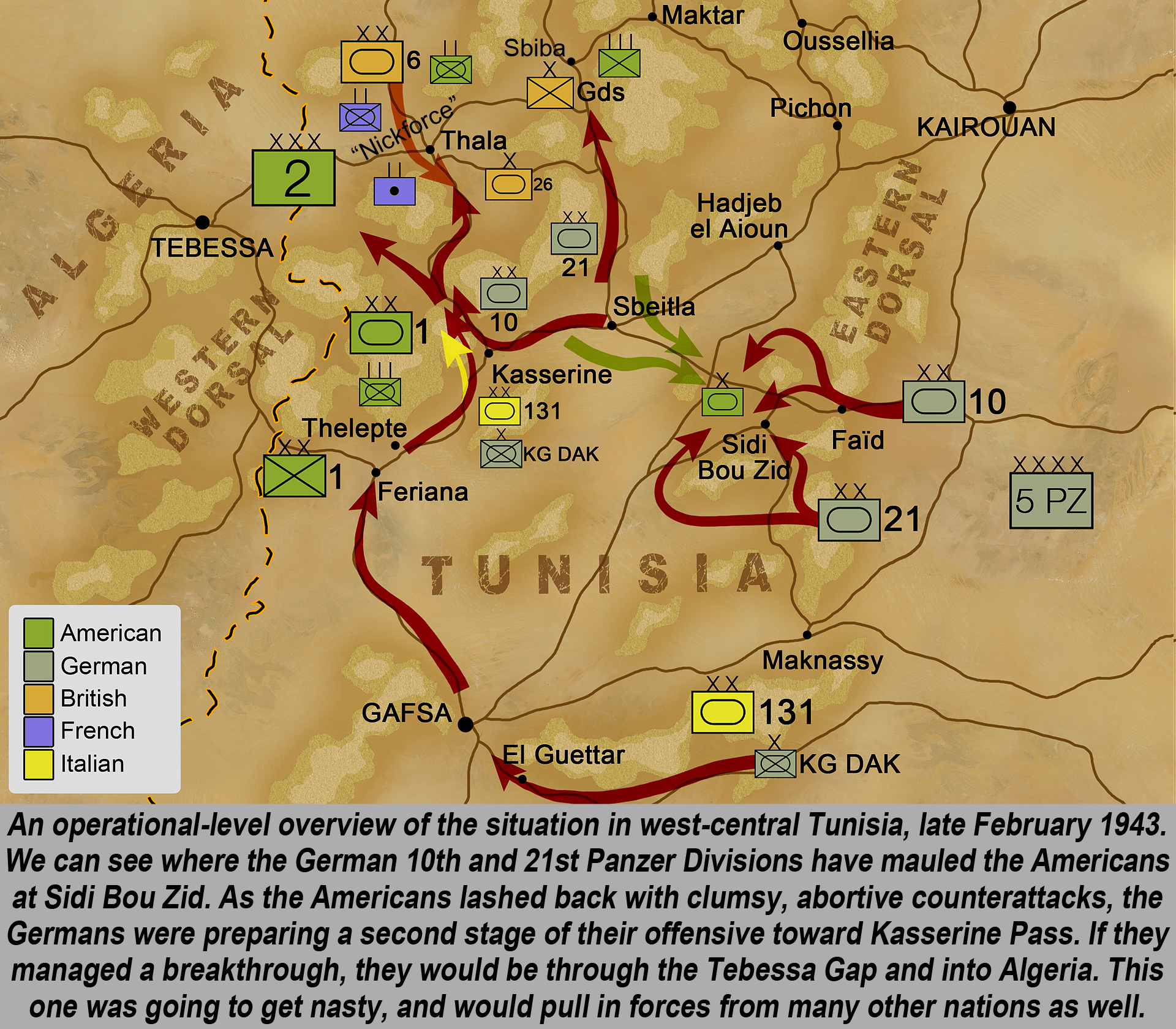
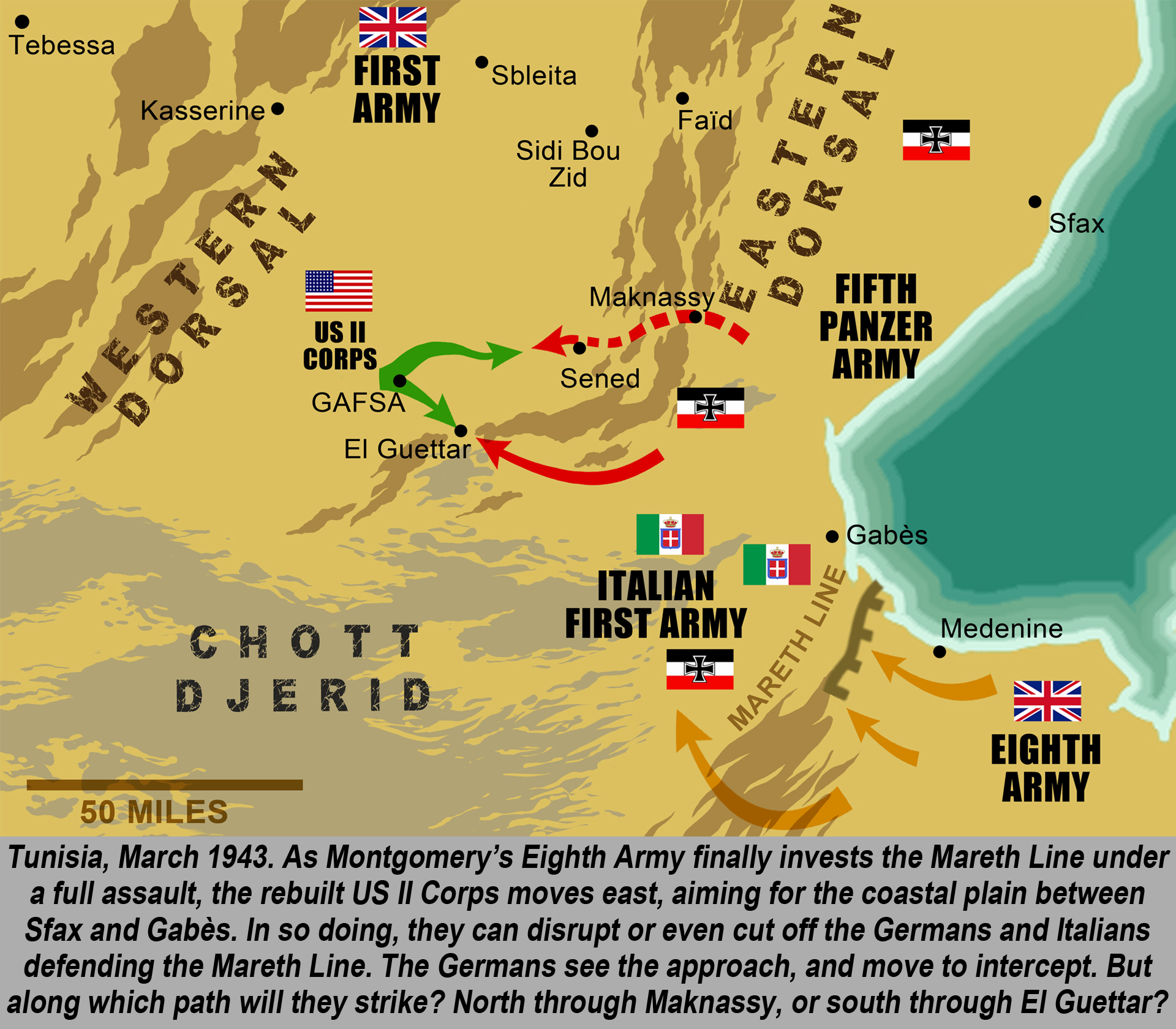
Indeed, that whole week was very eventful. We also include a larger, operational-scale map to provide more context to the tactical operations ongoing.
@jimwesterfield : As an old Panzer Leader / Panzer Blitz player it looks fantastic. Absolutely love that game system, warts and all. Granted, most of the people who still play the system actually take the rules mechanics out of Arab-Israeli Wars (third in the series) and retro-fit them back into PanzerBlitz/Leader. The only real issues are you need new artillery counters – adjustments to the Weapons Effectiveness Charts, etc. The real bugbear is the terrain, AIW terrain rules are written specifically for deserts which don’t jive well with Normandy bocage / Russian steppe. However for North African desert, it’s a… Read more »
Thanks for the link to the earlier series. Very interesting. Must have missed it when it came out. Best of luck with your gaming.
Cool deal. Thanks very much for the great comments and article links.
Hi Jim, many thanks for this fantastic start to our journey to the boot camp. It’s amazing to see how blinkered your historical knowledge can be when you only focus on main events, or what directly relates to you. Thanks for opening my eyes yet again to breadth of military history out there that’s still to be explored. Looking forward to the next one!
No worries at all, @brucelea . They say all battles are won or lost in the preparation, so we try to get the ramp-up to the boot camp started nice and early! Also, by showing the “whole” picture (even if only a quick cursory view), I’m hoping we can make different areas of gaming more inclusive to people’s interests and available armies and give people more ideas. Even for those who like “gaming in the gaps,” this just provides “more gaps” for them to try. 😀 Thanks for the comment! Really looking forward to the boot camp!
Aah! The 7 P’s……
PRIOR
PREPARATION &
PLANNING
PREVENT
P!55
POOR
PERFORMANCE!!!
Oh yes, I remember that from the Marine Corps as well, @brucelea (I think we shortened it to five, but same general idea). Another one from the Corps (and probably others as well): “The more you sweat in peace, the less you bleed in war.” Or as Sun Tzu put more eloquently: “Victorious warriors achieve victory first and then seek battle, while defeated warriors go to battle first … and then seek victory. Or as Josephus wrote of the Romans: “Their maneuvers are like bloodless battles … their battles like bloody maneuvers.” Or as Oriskany wrote: “Get your shit together… Read more »
?
???
I do my best.
@oriskany @commodorerob,@warzan think we have an ideal opportunity to prove that historical gaming isnt as hard to get into as it can appear, even if it has raised huge pages of messages on the various forum themes.
@bobcockayne that’s an idea… Maybe do a roundtable discussion on this topic during the bootcamp what do you think @warzan ?
@bobcockayne – we just recorded an interview for the weekender where we touch on this a little, and go over some of the media we will be presenting at the Boot Camp.
I dunno, man. This discussion’s been hit pretty hard, and I fear did a little unintended damage to be honest.
@oriskany thinking might be good to show how Bolt Action campaign are a good intro into the game and historical and you dont have to be as anal as we are!!!
I agree, @bobcockayne , and this is part of what went into this morning’s interview (hopefully air on the Saturday weekender). As far as “discussions” go, that’s all great. Maybe it’s me, but I just didn’t see too many concrete ideas, original concepts, and actionable tasks people were suggesting or willing to undertake themselves. I mean, I have 300,000 words in 120+ article on the site, making historical wargaming “more accessible.” I’ve designed and published wargames on the site. I’ve undertaken research projects for people on the site, and provided consultation services to help get their games off the ground.… Read more »
@Jim Totally agree, not that I read the whole thread,but did get that gist. Wish I had more time to help, but most of spare time is spent painting as I pretty much paint everything my group uses. I’ve put on demo games both Sci fi and Historical and can only guess at the amount of effort you must put in. I’m happy to help at bootcamp but as I actually started in Historical gaming (there wasnt any sci fi-fantasy games when I was an nipper) I might not be the best advert . I think some going to bootcamp… Read more »
Just a thought but when I started gaming the lack of sci-fi/Fantasy may have been due to its lack of popular media exposure at the time compared to the mountain of ‘historical’ (big inverted commas) movies from the 50’s and 60’s we had been exposed to , now compare that to today where the opposite could be said to be true, films like Dunkirk, Heartbreak ridge are the rare but sci-fi fantasy.
Back in the day you were a bit of a geek to read sci-fi fantasy never mind play it, now it appears the opposite is true.
Absolutely. I remember when kids who read comic books got beat up and head-flushed in the boys room. Now they RULE THE WORLD! 😮
No worries at all @bobcockayne – I certainly wasn’t speaking about you personally. In a more general sense, the conversation gets a little annoying when the tangent inevitably comes up “the team needs to do more to make historical wargaming accessible” or “historical wargamers need to be more accessible.” And yet I don’t see any sci-fi or fantasy community members piling out hundreds of pages of content trying to open their genres for new gamers. Actually, I take that back, I’ve seen exactly two – one series a piece, in nearly five years on the site. And yet you get… Read more »
I remember. your Battletech series shame you got flak on it, It is historical, well my history anyway, I’ll have to reread it. If we get chance at bootcamp you can perhaps tell me what you had planned, and I may have a go at putting something together,like to see it get a bit more mention.
Thanks, @bobcockayne – oh, it got tons of mention. Perhaps a bit too much, measured by comments it was far and away the most successful article series yet produced on BoW (1300+ all told). It was just that no matter what I said, I was getting “something wrong” based on some novel that was refuted by the next reader, this was canon, this wasn’t canon, this ‘mech was taken out of canon after such-and-such lawsuit by Harmony Gold, this timeline split when Microsoft bought some of the license rights for the Mechwarrior PC series, then merged BACK into canon when… Read more »
My old group had one of those, mainly because he couldnt jump all round the table without being shot tp pieces curtosy of pulse lasers and targetting computers,
I was a merc, own regiment Knights Mercian ( old star league 101st Royal Hussars)
First off … Whoo hoo! Triple digits on the comments!
Personally I never really liked jump jets. Too much heat, too big of a penalty to hit with your weapons when you landed.
@oriskany some of its even on topic!
My bad!!!!
Do youvhave any idea which bit of the desert war we are doing,dont say anything , though from what I remember of whats in Warlords starter Armys its going to be 41 onwards.Most of both Armys kit was still being used in 42, but dont think. Includes anything over the top such Panzer IV specials, Shermans or Grants.
@bobcockayne – I have seen preliminary lists. They were infantry (squads & weapons teams) – 1 vehicle only, not a tank. I shouldn’t confirm that for sure since I don’t know if that list was ever set in stone, and if it was, if I should be divulging it. So again, this is only what I have HEARD. Infantry weapons don’t change very much between 1941 and 41. Yes, it would have to be 1941 onwards since we’re getting Germans (Rommel’s opening offensive starts in late March-April). 😀 The only real difference would be whether the German MG teams have… Read more »
They do look like they are tweaked lists to the Starter Armys/1000pts armies on the Warlord site, I think Warren said we start with 600pts and build up to the 1000pts. The site armys differ in composition between the starter and 1000 pts in stuff in the starter (mainly anti-tanks guns and tanks) disappear in the 1000pts ones. which would explain some part of the secrecy. You know apart thinking about it apart from a rough idea on time period( and your period is what I guessed as it allows for more open warfare than the fixed positions of later)… Read more »
@bobcockayne – “They do look like they are tweaked lists to the Starter Armies/1000pts armies on the Warlord site …” Have the lists actually been published for the Boot Camp? I didn’t know that. “I think Warren said we start with 600pts and build up to the 1000pts.” Based on the “internals” I’ve seen, that’s going to be generally the case. I know the new Warlord starter army is published, I’m not 100% sure if those are the exact armies boot camp participants will be getting. “Play with what you get, another good reason for not bringing stuff with us.”… Read more »
@oriskany no, nothing has been said about composition of forces. As for bringing extras, thats purely my decision, basically as : 1. Weight allowance 2. Breakages, most of my stuff has pintle mounts etc and will have enough to do building new stuff to be bothered with fixing it, and things have a tendency to fall off moving them from room to room in apartment, when I was looking at old models had half the crew figures fall off, seems the superglue I used at time must have a ltd stick life! 3 Security at airport still remember Justin’s nightmare… Read more »
@bobcockayne – Okay, I have seen preliminary lists, but to my knowledge these haven’t been 100% finalized, so I really don’t want to say what they are. I can follow up with the rest of the BoW team and see if they’ve been finalized. I’ll let you know if I hear anything.
I do know it’s looking like 600 initial points, expanding to 1000 points.
Don’t worry about it @oriskany,no matter what it is I’ll have more of a clue what to do with it than the Wulsung botcamp, and it didn’t effect my enjoyment.
That’s all that counts. 😀
Wow, looks like this article really took off! Great start for the series, I like how we start off encompassing the whole desert conflict.
Thanks very much! Yeah, we’re including “everything” WW2 Desert War related so people have the broadest opportunity to play 28mm Bolt Action Desert games with whatever armies they have on hand, or of they’r interested in exploring options besides the classic “British / CW vs. Germans / Italians”.